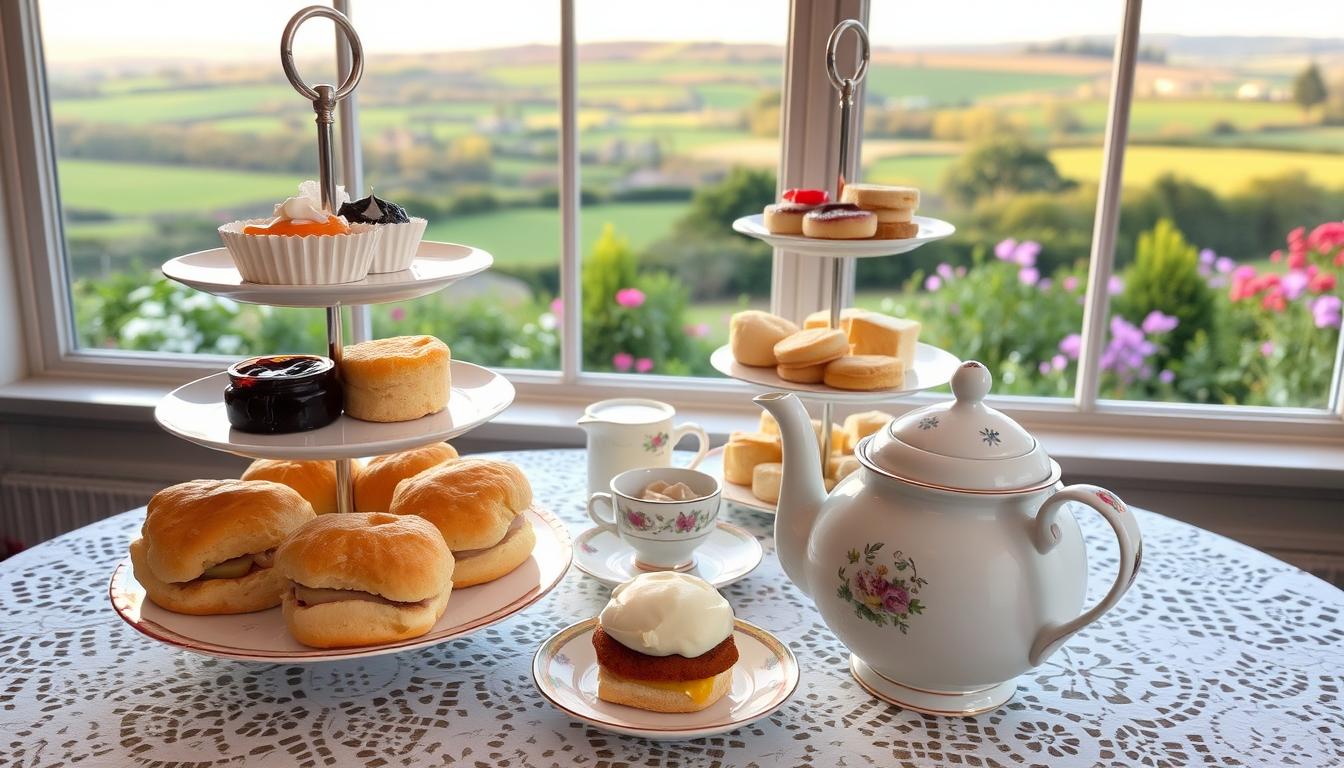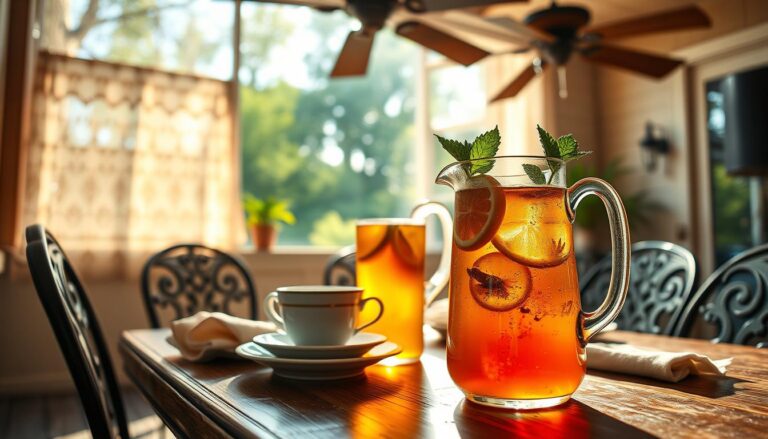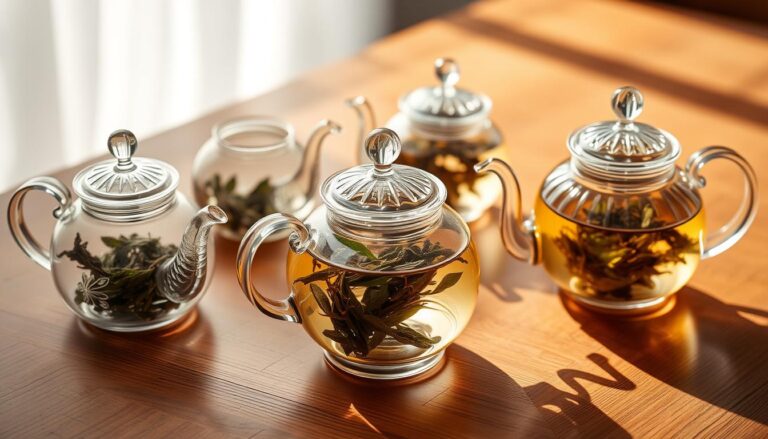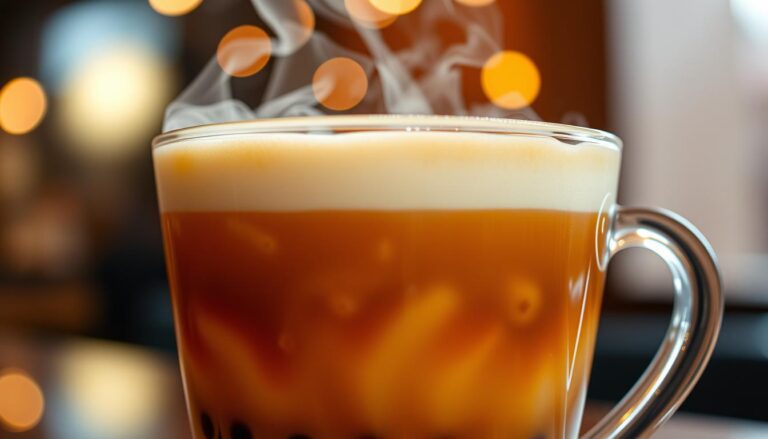What Is Cream Tea? 5 Things You Should Know About This Classic Drink
Every time I close my eyes and imagine a leisurely afternoon, I’m transported to a quaint English tea room. The aroma of freshly brewed traditional British tea fills the air. The cream tea experience is more than just a meal. It’s a cherished cultural ritual that connects generations through simple, delightful pleasures.
If you’ve ever wondered about this quintessential British tradition, you’re in for a treat. Cream tea is a delectable afternoon experience. It combines perfectly brewed tea with warm, buttery scones. These are topped with rich clotted cream and sweet jam. Originating in the beautiful regions of Devon and Cornwall, this culinary tradition has captured hearts worldwide.
Whether you’re a tea enthusiast or simply curious about British culinary traditions, understanding cream tea offers a delightful glimpse into a world of comfort, elegance, and timeless taste. Let’s explore five essential things that make cream tea a truly special gastronomic experience. It goes far beyond just a simple beverage.
Get ready to dive into the delicious world of cream tea. A journey that promises to tantalize your taste buds and transport you to the charming countryside of England.
Table of Contents
The Origins of Cream Tea
Cream tea is a cherished tradition in English culture. It starts with a look into its rich history.
The tale of cream tea begins in medieval England’s monasteries. Tavistock Abbey in Devon was key in its development in the 11th century.
A Monastic Beginning
Monks at Tavistock Abbey made a simple meal for workers. It included:
- Fresh bread
- Thick cream
- Local fruit preserves
Regional Variations
As cream teas spread, different areas developed their own styles. Devon and Cornwall are famous for their scone-serving ways.
| Region | Cream Tea Tradition | Unique Characteristic |
|---|---|---|
| Devon | Cream First Method | Thick clotted cream spread on scone first |
| Cornwall | Jam First Method | Jam spread before cream |
In the 19th century, afternoon tea became a fancy social event. Anna, Duchess of Bedford, made it elegant. It still charms tea lovers today.
What Is Included in Cream Tea?
Cream tea is a delightful culinary tradition that offers a perfect blend of flavors and textures. When you dive into this classic British treat, you’ll discover a carefully curated selection of delectable components. These make scones with clotted cream and jam an irresistible experience.
The heart of cream-tea revolves around several key ingredients that create a memorable afternoon indulgence. Let’s explore the essential elements that make this tea and pastries experience so special.
Traditional Components
- Scones: Freshly baked, soft, and slightly crumbly
- Clotted Cream: Rich, thick, and luxuriously smooth
- Jam: Usually strawberry or raspberry, homemade or high-quality preserves
- Tea: Typically black tea, such as English Breakfast or Earl Grey
Optional Additions
While traditional cream focuses on simplicity, some establishments offer expanded versions that include extra delights.
| Optional Items | Description |
|---|---|
| Finger Sandwiches | Delicate, crustless sandwiches with various fillings |
| Small Cakes | Miniature pastries to complement the scones |
| Additional Pastries | Light, sweet treats to enhance the tea experience |
Your Cream T journey can be as simple or elaborate as you prefer. Whether you stick to the classic combination or explore additional treats, the essence of Cream T remains a delightful celebration of flavor and tradition.
The Perfect Pairing: Scones
Scones are the heart of any authentic cream-tea. They make the tea experience unforgettable. When made right, scones turn a simple tea into a special moment.
The magic of a great scone is in its texture and versatility. A perfect scone is light, slightly crumbly, and holds a lot of clotted cream and jam well.
Exploring Scone Varieties
Scones come in many delicious types that can make your cream-tea better:
- Plain Scones: Classic and versatile
- Fruit Scones: Studded with raisins or currants
- Cheese Scones: A savory alternative
- Whole Wheat Scones: A healthier option
Selecting Your Ideal Scone
When picking scones for your cream tea, keep these tips in mind:
- Freshness: Always choose scones baked recently
- Texture: Look for a light, slightly crumbly feel
- Flavor: Pick a type that goes well with your tea
Whether baking at home or buying from a bakery, the right scone can make your cream-tea unforgettable.
Sweet vs. Savory: Which Is Better?
The debate over sweet and savory cream teas is a favorite among food lovers. Your ideal cream depends on what you like best.
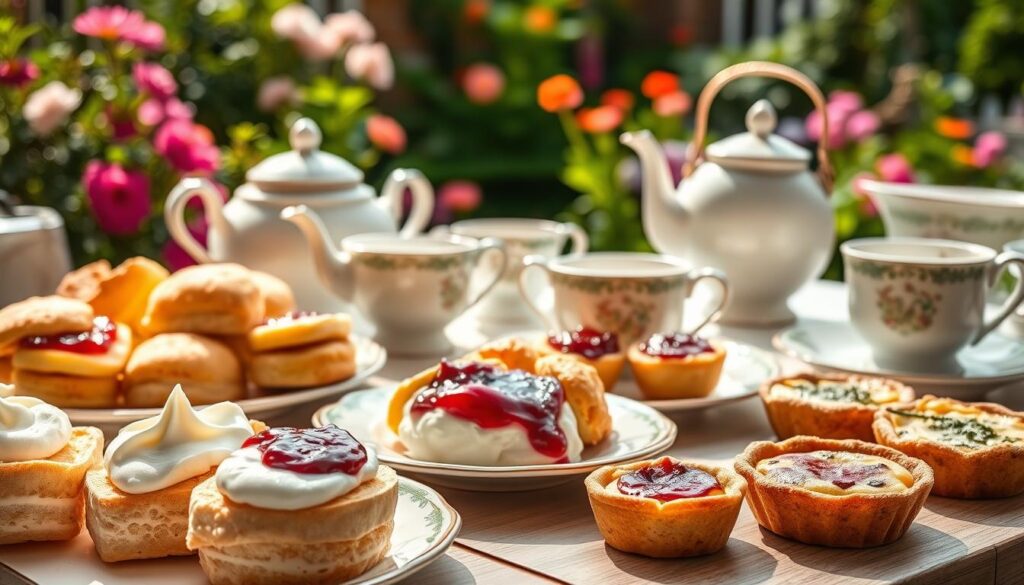

Cream tea comes in many flavors, pleasing both sweet and savory fans. Let’s look at the main choices.
The Sweet Sensation
Traditional cream-tea is sweet, with flavors that have won hearts for years. It usually includes:
- Freshly baked scones
- Clotted cream
- Strawberry or raspberry jam
- A perfectly brewed cup of black tea
The Savory Alternative
For those who prefer less sugar, savory cream tea is a great choice. It adds a new twist to the classic.
| Savory Cream Tea Components | Flavor Profile |
|---|---|
| Cheese scones | Sharp and tangy |
| Herb-infused spreads | Aromatic and rich |
| Vegetable-based toppings | Fresh and light |
Your taste decides the best cream tea. Many places offer both sweet and savory, letting you try them all.
Remember, there’s no right or wrong way to enjoy your cream-tea – only your personal preference matters!
Pro tip: Don’t be afraid to mix and match. Some tea enthusiasts enjoy sampling both sweet and savory cream-tea varieties in one sitting.
Brewing the Ideal Cup of Tea
Learning to make traditional British tea is key for anyone who loves cream tea. The right brew can make your tea time special. It turns a simple moment into a lovely ritual. Whether you’re new to tea or have been drinking it for years, knowing how to brew it well will make your cream-tea better.
Picking the right tea is the first step to a great cream-tea. Each tea has its own taste that can go well with your scones and other treats.
Recommended Teas for Cream Tea
- Earl Grey: A classic choice with bergamot oil undertones
- English Breakfast: A strong black tea great for any time of day
- Darjeeling: Known as the “champagne of teas” with light flavors
Brewing Techniques
Making traditional British tea needs careful attention. The water’s temperature and how long you steep it can change the taste and quality of your tea.
| Tea Type | Water Temperature | Steeping Time |
|---|---|---|
| Black Tea | 212°F (100°C) | 3-5 minutes |
| Green Tea | 175-185°F (80-85°C) | 2-3 minutes |
| Darjeeling | 195°F (90°C) | 3 minutes |
Here are some tips for the perfect cup: Use fresh, cold water. Warm your teapot before you start. If you’re using loose leaf tea, a good infuser helps get the best flavor.
“A great cup of tea is an art form, carefully crafted with patience and precision.” – Tea Enthusiast
Cream Tea Etiquette
An English tea party is more than just a meal—it’s a cherished social tradition. It requires finesse and understanding. Knowing the subtleties of cream tea etiquette can make any gathering elegant.
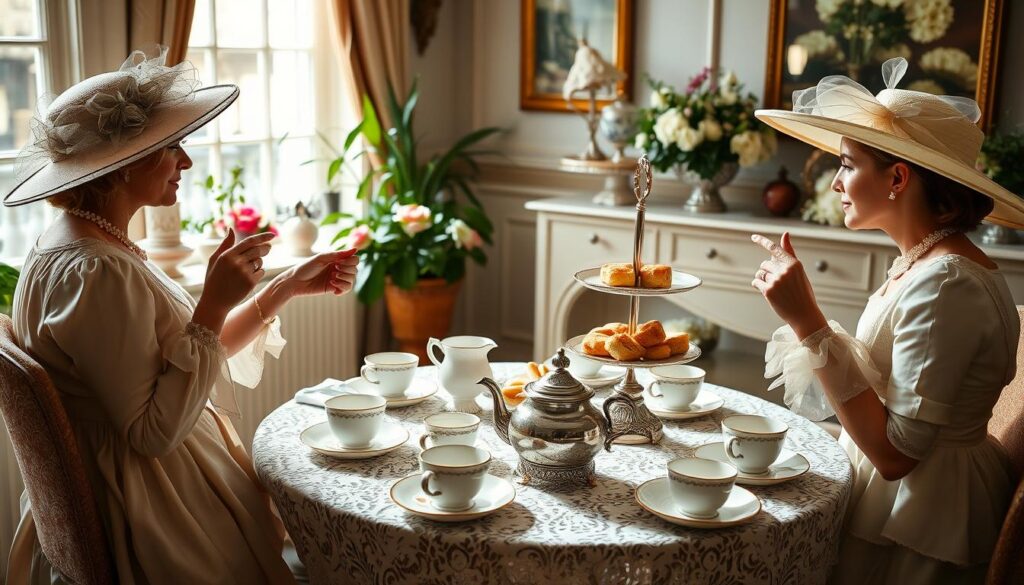

When hosting or attending an English tea party, certain guidelines are key. They ensure a sophisticated and enjoyable event. Here are some tips to help you become a cream-tea connoisseur:
Serving with Sophistication
- Always serve tea in proper porcelain cups
- Arrange scones, clotted cream, and jam neatly on a tiered stand
- Pour tea after guests are seated
- Offer milk and sugar separately
Social Graces at the Table
During your English tea party, remember these essential etiquette tips:
- Use a teaspoon to stir gently without clinking
- Hold your teacup delicately by the handle
- Place your napkin on your lap
- Avoid dunking biscuits or scones directly into tea
Enjoying with Friends
The true magic of cream-tea lies in conversation and connection. Create a warm atmosphere by engaging in light, pleasant dialogue. Discuss shared interests, but avoid controversial topics that might disrupt the relaxed ambiance of your English tea party.
“Tea is the gentle art of friendship and refinement.”
By following these guidelines, you’ll host an impeccable cream. It celebrates tradition while creating memorable moments with friends.
Popular Places to Enjoy Cream Tea
Start your search for the perfect tea room experience by finding the best cream tea spots in the United States. Although it comes from Britain, tea lovers across the country have made it their own. They’ve found charming places to enjoy this delightful tradition.
Noteworthy Tea Rooms Across America
Looking for the ideal cream tea spot can turn a simple afternoon into a memorable food journey. Here are some top places that promise to delight your senses:
- The Queen Mary Tea Room in Seattle, Washington – a Pacific Northwest gem
- Charleston Tea Room in South Carolina – Southern hospitality meets elegant tea service
- Bosie Tea Parlor in New York City – innovative cream tea with French-inspired touches
- Tea Rose Garden in Pasadena, California – intimate setting with authentic British flair
Unique Cream Tea Experiences
Maybe your best cream tea adventure is waiting in an unexpected place. Think about trying:
- Botanical garden tea services
- Historic house museum afternoon teas
- Seasonal festival tea events
- Luxury hotel tea rooms
Every place has its own special way of serving cream tea. This makes sure your experience is both memorable and enjoyable.
Homemade Cream Tea: A Step-by-Step Guide
Making your own cream tea at home is simpler than you think. This British tradition can be made in your kitchen with a few ingredients and patience. This guide will help you make a real cream, whether you love tea or baking.
To make a cream tea, you need scones, clotted cream, and tea. Each part is important for a great afternoon treat.
Crafting Delicious Scones
Scones are the base of any cream tea. Here’s how to make them easily:
- Use cold butter for flakier texture
- Mix dry ingredients thoroughly
- Handle dough minimally to keep scones tender
- Brush with egg wash for golden color
Essential Ingredients for Cream Tea
| Ingredient | Quantity | Purpose |
|---|---|---|
| All-purpose flour | 2 cups | Scone base |
| Butter | 1/2 cup | Adds richness |
| Clotted cream | 1/2 cup | Traditional topping |
| Strawberry jam | 1/4 cup | Sweet complement |
Brewing the Perfect Tea
Choose a good black tea like English Breakfast or Earl Grey. Use boiling water and steep for 3-5 minutes. The right water temperature and steeping time are key for the best flavor.
Follow these steps to make a wonderful cream tea. It will feel like you’re in the British countryside. Enjoy your homemade tea time!
Cream Tea Around the World
Traditional British tea has spread far beyond its roots, becoming a favorite around the globe. It has brought people together, showing how a simple tradition can unite us. This is through the joy of sharing a cup of tea.
Countries have put their own spin on cream tea, mixing it with local tastes and traditions. You’ll find amazing versions that keep the original spirit alive while adding new flavors.
Global Cream Tea Innovations
- Australia incorporates native bush honey into scone recipes
- India blends traditional British tea with masala chai spices
- Japan creates elegant tea ceremonies with minimalist presentation
- United States develops fusion versions with local ingredients
International Cream Tea Favorites
Cream tea has grown into a cultural exchange, not just a drink. Each nation puts its own twist on the British tea tradition. This creates exciting new flavors that delight tea lovers everywhere.
In places like Tokyo’s tea rooms and Melbourne’s cafes,It’s keeps changing. Now, you can enjoy this tradition in many ways. Each place offers a special look into their culture and creativity in food.
Fun Facts About Cream Tea
It is more than a tasty treat—it’s a cultural treasure that brings people together. It has a rich history and is loved by many. From cozy tea rooms in Devon to fancy English tea parties, it’s a cherished tradition.
Did you know cream was a symbol of British strength during World War II? Families came together, sharing scones and tea. It helped keep spirits high and brought comfort in tough times. Some say it’s a key part of British identity.
It is more than just a snack. It’s a chance to take a break and enjoy good company. Whether you’re in a charming café or making it at home, it’s a taste of British history. This tradition has stayed the same for centuries.
In places like Cornwall and Devon, there’s a big debate about cream. The question is, should you put jam or clotted cream on the scone first? This friendly argument shows how much this tradition means to locals. It’s not just a meal, but a way to connect and show pride in your region.

